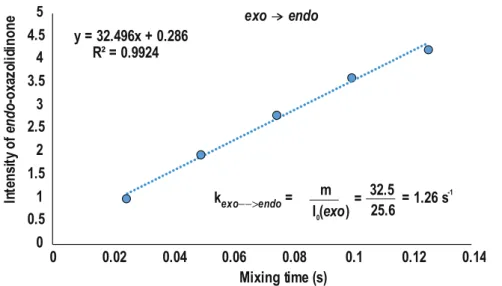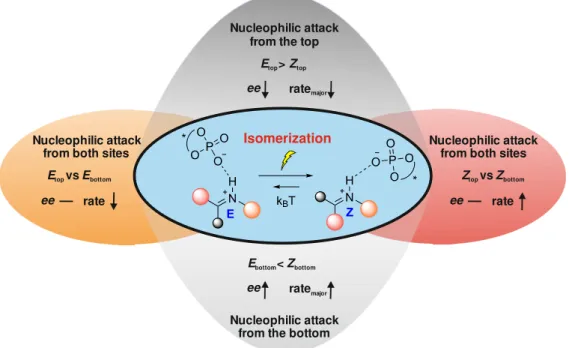NMR Spectroscopic Investigations on Asymmetric Aminocatalysis
Dissertation
zur Erlangung des Doktorgrades der Naturwissenschaften (Dr. rer. nat.)
der Fakultät für Chemie und Pharmazie der Universität Regensburg
vorgelegt von Andreas Seegerer
aus Vilseck im Jahr 2018
Die vorliegende Dissertation beruht auf Arbeiten, die zwischen November 2014 und April 2018 am Arbeitskreis von Frau Professor Dr. Ruth M. Gschwind am Institut für Organische Chemie der Universität Regensburg durchgeführt wurden.
Promotionsgesuch eingereicht: April 2018
Die Arbeit wurde angeleitet von: Prof. Dr. Ruth M. Gschwind Promotionsausschuss:
Vorsitzender: Prof. Dr. Alkwin Slenczka
1. Gutachter: Prof. Dr. Ruth M. Gschwind
2. Gutachter: Prof. Dr. Werner Kremer
3. Prüfer: Prof. Dr. Julia Rehbein
NMR Spectroscopic Investigations on Asymmetric Aminocatalysis
Andreas Seegerer
Table of Contents
1 Introduction and Outline ... 1
2 Remote-Stereocontrol in Dienamine Catalysis: Z-Dienamine Preferences and Electrophile-Catalyst Interaction Revealed by NMR and Computational Studies ... 5
2.1 Abstract ... 7
2.2 Introduction ... 8
2.3 Results and Discussion ... 11
2.3.1 Model System and Theoretical Levels ... 11
2.3.2 Structure of Dienamines ... 12
2.3.3 Enantioselectivity and Kinetic Control ... 17
2.3.4 Computational Details ... 27
2.4 Conclusion ... 27
2.5 References ... 29
2.6 Supporting Information ... 32
2.6.1 NMR Measurements ... 32
2.6.2 Dienamine Intermediates ... 32
2.6.3 Product Species ... 40
2.6.4 Procedure for the Gamma-Alkylation of trans-Pentenal ... 42
2.6.5 HPLC Analysis ... 44
2.6.6 UV/Vis Spectra ... 48
2.6.7 Computational Studies ... 48
2.6.8 References ... 48
3 Chemical Exchange Saturation Transfer in Chemical Reactions: A Mechanistic Tool for NMR Detection and Characterization of Transient Intermediates ... 49
3.1 Abstract ... 51
3.2 Introduction ... 52
3.3 Results and Discussion ... 56
3.4 Conclusion ... 69
3.5 References ... 70
3.6 Supporting Information ... 73
3.6.1 General Information ... 73
3.6.2 Synthesis of DPU-d10 ... 73
3.6.3 Sample Preparation ... 73
3.6.4 NMR Spectroscopic Investigations in the Absence of DPU at 300-215 K . 74 3.6.5 NMR Spectroscopic Investigations in the Presence of DPU ... 75
3.6.6 Charge and Bond Length Analysis ... 78
3.6.7 Effect of Temperature on E-Iminium Population in Presence of DPU ... 79
3.6.8 1D 1H EXSY Studies to Obtain Rate Constants and Free Energy Barriers 80 3.6.9 1H CEST Pulse Sequence ... 83
3.6.10 Possible Intermediate Probes to Detect Iminium Ion in the System ... 83
3.6.11 Bloch-McConnell Equations for Two Site Exchange ... 84
3.6.12 CEST Spectra (Profile) Simulation Details ... 85
3.6.13 Details of Theoretical Calculations ... 86
3.6.14 References ... 87
4 Decrypting Transition States by Light: Chances, Possibilities and Limitations. A Preliminary Study in Iminium Ion Catalysis ... 89
4.1 Basic Concept of DTS-hν ... 91
4.2 DTS-hν ‒ A Theoretical Approach For More Complex Systems ... 95
4.2.1 Application of DTS-hν in Asymmetric Aminocatalysis ... 95
4.2.2 DTS-hν Fingerprint Patterns in Iminium Ion Catalysis ... 96
4.3 Experimental Application of DTS-hν ... 103
4.3.1 Model Reaction ... 103
4.3.2 NMR Spectroscopic Investigations ... 106
4.4 Conclusion ... 111
4.5 Experimental Part ... 112
4.6 Additional Findings ... 119
4.6.1 6π-Electrocyclizations ... 119
4.6.2 Experimental Part ... 124
4.7 References ... 125
5 Combined in situ Illumination-NMR-UV/Vis Spectroscopy: A New Mechanistic Tool in Photochemistry ... 129
5.1 Abstract ... 131
5.2 Introduction ... 133
5.3 Results and Discussion ... 136
5.4 Conclusion ... 141
5.5 References ... 142
5.6 Supporting Information ... 144
5.6.1 Setup ... 144
5.6.1.1 General Information ... 144
5.6.1.2 Electronic Setup ... 144
5.6.1.3 Spectroscopy Setup ... 146
5.6.1.4 Automation and Modification of Pulse Sequences ... 149
5.6.1.5 Comparison of Reaction Rates – Conventional LED Illumination Setup vs New Combined LED UV/Vis Illumination Setup ... 153
5.6.2 Summary of conPET Processes and Investigations of the Photoreduction of Aryl Halides with PDI as Photocatalyst ... 156
5.6.2.1 Summary of conPET Processes ... 156
5.6.2.2 Investigations of the Photoreduction of Aryl Halides with PDI as Photocatalyst ... 158
5.6.2.2.1 General Information ... 158
5.6.2.2.2 Assignments of Starting Materials, Catalyst and Products ... 161
5.6.3 Investigation of a Common Photoswitch ... 163
5.6.3.1 General Information ... 163
5.6.3.2 Assignments of 1 and its Open Form 2 ... 165
5.6.3.3 NMR and UV/Vis Build Up and Decay Curves of 2 ... 168
5.6.3.3.1 Isomerization Experiments at 300 K ... 168
5.6.3.3.2 Isomerization Experiments at 180 K ... 170
5.6.3.4 Photodegradation ... 171
5.6.4 References ... 172
6 Conclusion ... 173
1 Introduction and Outline
In 2018, asymmetric aminocatalysis represents one of the most important strategies in organocatalysis and hundreds of different enantioselective transformations catalyzed by small chiral amines are known.1 However, going back around 20 years in history, the field of asymmetric aminocatalysis had, except for a marginal number of publications, not even been discovered.2 Although the power of small organic molecules, to catalyze organic reactions, has been known for much more than a hundred years,3 their triumph in asymmetric transformations has been long in coming. Nowadays, the development of the Hajos-Parrish-Eder-Sauer-Wiechert reaction in the early 1970’s,4 enabling the first highly enantioselective transformation catalyzed by L-proline, is regarded as one of the most important milestones in enantioselective organocatalysis. However, back then, “its potential has not been realized […] and remained little more than a laboratory curiosity”
(List, B. Chem. Rev. 2007, 107, 5471).
Finally in 2000, two pioneering publications of List and MacMillan managed to focus the broad interest of the organic chemistry community on asymmetric organocatalysis.5,6 The introduction of two concepts, describing the activation of aldehydes or ketones by HOMO activation (enamines) and LUMO lowering (iminium ions) and the corresponding conversions with electrophiles or nucleophiles was the start for a great story of success.
Beginning with the application of L-proline and its derivatives as secondary amino catalysts, the steady development of new reactions, cascades and catalysts led to a gold rush in organocatalysis.7 Within a few years, hundreds of publications proved the huge scope of aminocatalysis and helped to establish the field as an important pillar in organocatalysis.8
Besides the fast development in terms of reaction design, especially in the beginning of the golden era of asymmetric organocatalysis, detailed mechanistic investigations and studies were scarce. However, insights in reaction pathways and their corresponding kinetics and thermodynamics can be essential to improve yields and enantiomeric excess of reactions. Furthermore, information about the reaction mechanisms is of utmost importance in designing new types of reactions, substrates and catalysts.
Beginning with the first detection of an elusive enamine intermediate in 2010, our working group contributed several important NMR spectroscopic studies about the formation, stability and structure of enamine intermediates during recent years.9 The goal of this thesis was to use this experience to shed light on additional mechanistic issues in secondary aminocatalysis and to increase the number of options to solve current and future mechanistic questions by the implementation of new NMR spectroscopic tools and techniques.
The first issue analyzed in this thesis, is the remote-stereocontrol in asymmetric dienamine catalysis with Jørgensen-Hayashi type catalysts. The concept of dienamine catalysis represents a vinylogous version of enamine catalysis to enable the catalytic functionalization of α,β-unsaturated aldehydes in their α or γ positions.10 As in enamine catalysis, a stereoinduction caused by a steric shielding of one site of the intermediates by the catalyst was assumed. However, the elongated distance between the shielding moiety and the active γ position of the dienamine intermediates, and a Z/E ratio of the second double bond deviating from the ee values observed in synthesis, left room for speculations.
Therefore, in chapter 2, an NMR spectroscopic analysis of the structure of the dienamines, derived by the condensation of different aldehydes and catalysts is presented. Furthermore, detailed spectroscopic and computational studies to investigate the formation of the dienamine intermediates are shown and the observed Z/E ratios regarding the diene subsystem are explained. Based on the shift of the rate determining step of the reaction by the modulation of the acidic additive, for the first time a kinetic preference for conversion of the Z dienamine is proven experimentally. In combination with detailed computational analyses, revealing catalyst specific CH-π interactions in the transition states, a delicate interplay between structure, formation and conversion was found to be responsible for a highly effective remote-stereocontrol in dienamine catalysis.
In chapter 3, the focus of the investigations is shifted to the related field of enamine catalysis. Here, in the case of proline catalyzed reactions, a long controversial discussion about the role of iminium ions in the proline catalyzed enamine formation arose already years ago.11 Due to the lack of a direct experimental access to iminium ion intermediates, their general importance for the formation process of enamines respectively their competition with oxazolidinone intermediates was unclear.
The main problem for the in situ detection of the iminium ions by NMR spectroscopy was
Therefore, in chapter 3, the chemical exchange saturation transfer (CEST) technique, providing a higher sensitivity, was applied for the first time for the detection of transient reaction intermediates in organocatalysis, proving the missing iminium ion intermediate in a proline catalyzed enamine formation.
In addition to chapter 3, the last two chapters of this thesis are also focused on the development and application of new experimental methods and NMR spectroscopic tools. In general, the steady advancement of existing techniques and the development of new ones are essential to facilitate and to enable the analysis of recent and future mechanistic issues. A great example for this progress in reaction mechanism analysis can be found in the decrypting transition states by light (DTS-hv) method, which was recently developed in our working group.12 This new method describes an experimental way to investigate the dominant reaction pathway, by a light induced modulation of double bonds, whose configurations are essential for the stereocontrol of a reaction.
Due to the great success in proving the dominant pathways for two Brønsted acid catalyzed reactions of aldimines and ketimines containing one double bond, the idea of a transfer of the DTS-hv method to a more complex system, possessing two double bonds, is described in chapter 4. Based on the example of iminium ion intermediates, derived by the condensation of α,β-unsaturated aldehydes and a Jørgensen-Hayashi catalyst, a detailed theoretical approach of the method is presented. Additionally, first preliminary experimental results applying the DTS-hv method for a [3+3] annulation via iminium ion catalysis are shown and the effect of light on iminium ion intermediates is investigated.
A further example for a new tool in reaction mechanism analysis can be found in chapter 5. Here, an innovative setup for the combination of UV/Vis spectroscopy, NMR spectroscopy, and an in situ illumination device is introduced. The fully automated triple combination allows for a simultaneous and time-resolved detection of both diamagnetic and paramagnetic species by merging the specific benefits of the NMR and UV/Vis spectroscopy methods. Therefore, for the first time, this optical fiber based setup enables the acquisition of combined UV/Vis and NMR reaction profiles under the influence of an additional light source, directly inside the magnet. Furthermore, it circumvents all common issues compared to measurements conducted in separated setups, such as deviating concentrations, conditions, light intensities, as well as convection and diffusion.
The advantages of the UVNMR-illumination setup are demonstrated on the analysis of a consecutive photoinduced electron transfer (conPET) process13 and on the isomerization of a photoswitchable spiropyran.
(1) List, B. Synlett 2001, 2001, 1675; Dalko, P. I.; Moisan, L. Angew. Chem. Int. Ed.
2004, 43, 5138.; Erkkilä, A.; Majander, I.; Pihko, P. M. Chem. Rev. 2007, 107, 5416.;
Mukherjee, S.; Yang, J. W.; Hoffmann, S.; List, B. Chem. Rev. 2007, 107, 5471.;
Bertelsen, S.; Jørgensen, K. A. Chem. Soc. Rev. 2009, 38, 2178.
(2) MacMillan, D. W. C. Nature 2008, 455, 304.
(3) Wöhler, F.; von Liebig, J., Ann. Pharm. 1832, 3, 249.; von Liebig, J., Justus Liebigs Ann. Chem. 1860, 113, 246.; Knoevenagel, E., Ber. Dtsch. Chem. Ges. 1896, 29, 172.; Bredig G.; Fiske, P.S., Biochem. Z. 1912, 46, 7
(4) Eder, U.; Sauer, G. R.; Wiechert, R., German patent 1971, DE2014757.; Hajos, Z. G.; Parrish, D. R. German patent 1971, DE2102623.; Eder, U.; Sauer, G.; Wiechert, R. Angew. Chem. Int. Ed. 1971, 10, 496.; Hajos, Z. G.; Parrish, D. R. J. Org. Chem.
1974, 39, 1615.
(5) List, B.; Lerner, R. A.; Barbas III, C. F. J. Am. Chem. Soc. 2000, 122, 2395.
(6) Ahrendt, K. A; Borths, C. J.; MacMillan, D. W. C. J. Am. Chem. Soc. 2000, 122, 4243.
(7) Melchiorre, P.; Marigo, M.; Carlone, A.; Bartoli, G. Angew. Chem. Int. Ed. 2008, 47, 6138.
(8) Donslund, B. S.; Johansen, T. K.; Poulsen, P. H.; Halskov, K. S.; Jørgensen, K. A. Angew. Chem. Int. Ed. 2015, 54, 13860.
(9) Renzi, P.; Hioe, J.; Gschwind, R. M. Acc. Chem. Res. 2017, 50, 2936.
(10) Marcos, V.; Alemán, J. Chem. Soc. Rev. 2016, 45, 6812.
(11) Nielsen, M.; Worgull, D.; Zweifel, T.; Gschwend, B.; Bertelsen, S.; Jørgensen, K.
A. Chem. Commun. 2011, 47, 632.; Ashley, M. A.; Hirschi, J. S.; Izzo, J. A.; Vetticatt, M.
J. J. Am. Chem. Soc. 2016, 138, 1756.; Haindl, M. H.; Hioe, J.; Gschwind, R. M. J. Am.
Chem. Soc. 2015, 137, 12835.
(12) Renzi, P.; Hioe, J.; Gschwind, R. M. J. Am. Chem. Soc. 2017, 139, 6752.
(13) Ghosh, I.; Ghosh, T.; Bardagi, J. I.; Konig, B. Science 2014, 346, 725.
2 Remote-Stereocontrol in Dienamine Catalysis: Z-Dienamine Preferences and Electrophile-Catalyst Interaction Revealed by NMR and Computational Studies
Remote-Stereocontrol in Dienamine Catalysis
Z/E = 2/1
E+
E+
E+ 9/1
Andreas Seegerer, Johnny Hioe, Michael M. Hammer, Fabio Morana, Patrick J. W.
Fuchs and Ruth M. Gschwind.
J. Am. Chem. Soc., 2016, 138, 9864–9873 DOI: 10.1021/jacs.6b04008
The majority of the NMR measurements and their analysis presented in this chapter were performed by Andreas Seegerer. All computational studies were done by Dr.
Johnny Hioe. Initial NMR experiments about the influence of temperature and acid on this system were performed by Dr. Michael Hammer. Dr. Fabio Morana was responsible for the preparation of all HPLC samples, which were analyzed by Patrick J. W. Fuchs in Leipzig.
Reprinted (adapted) with permission from J. Am. Chem. Soc. 138, 31, 9864-9873. Copyright (2016) American Chemical Society. Source of this chapter: https://pubs.acs.org/doi/abs/10.1021/jacs.6b04008
2.1 Abstract
Catalysis with remote-stereocontrol provides special challenges in design and comprehension. One famous example is the dienamine catalysis, for which high ee values are reported despite insufficient shielding of the second double bond. Especially for dienamines with variable Z/E-ratios of the second double bond no correlations to the ee values are found. Therefore, the structures, thermodynamics and kinetics of dienamine intermediates in SN-type reactions are investigated. The NMR studies show that the preferred dienamine conformation provides an effective shielding if large electrophiles are used. Calculations at SCS-MP2/CBS-level of theory and experimental data of the dienamine formation show kinetic preference for the Z-isomer of the second double bond and a slow isomerization toward the thermodynamically preferred E-isomer.
Modulations of the rate determining step by variation of the concentration of the electrophile, allow the conversion of dienamines to be observed. With electrophiles a faster reaction of Z- than of E-isomers is observed experimentally. Calculations corroborate these results by correlating ee values of three catalysts with the kinetics of the electrophilic attack and reveal the significance of CH-π and stacking interactions in the transition states. Thus, for the first time a comprehensive understanding of the remote-stereocontrol in γ-functionalization reactions of dienamines and an explanation to the “Z/E-dilemma” are presented. The combination of bulky catalyst subsystems and large electrophiles provides a shielding of one face and causes different reactivities of E/Z-dienamines in nucleophilic attacks from the other face. Kinetic preferences for the formation of Z-dienamines and their unfavorable thermodynamics support high ee values.
2.2 Introduction
Remote-stereocontrol is a noble goal in asymmetric catalysis but a challenge in understanding and design. Prominent examples for the application of this remote- stereocontrol in organocatalysis are found in dienamine,1–3 trienamine3,4 and tetraenamine3,5 transformations. In some of these reactions, very high ee values were reported, and for the sterically demanding Diels-Alder type reactions, a plausible reaction mechanism was proposed.2,6 However, for SN-type γ-functionalization of dienamines detailed mechanistic studies and experimental insights into the underlying mechanism are, to our knowledge, very limited. This may obviously hamper the further development of the field. The main points under question are the partial shielding of the catalyst moiety and the “Z/E-dilemma” of the second double bond in linear aldehydes (see Figure 1) similar to the “Z/E-dilemma” known for iminium ion catalysis.7
Z/E R/S=
Figure 1. “Z/E-dilemma” in dienamine catalysis, i.e., the correlation between the Z/E- ratio of the second double bond and the R/S-ratio of the products is in dispute.
The dienamine catalysis, which is closely related to the enamine catalysis, has emerged as one of the most promising stereoinducing catalytic models in the α- and γ- functionalization of unsaturated aldehydes.1,2,8–13 This concept represents a vinylogous version of enamine activation, magnifies the nucleophilic character of the γ-carbon, and enables functionalization reactions of conjugated aldehydes at their α- or γ-position (Figure 2).2 The first selective γ-functionalization of unsaturated aldehydes with Jørgensen-Hayashi-type catalysts3,14–16 was presented by Jørgensen et al. in 2006.2 Later, the principle of γ-functionalization of dienamines was extended to SN1-type reactions with bis[4-(dimethylamino)phenyl]methanol as electrophile source by
obtained. For aldehydes, which are disubstituted at the γ-position, the α-alkylated aldehyde was observed as a major product, and in the case of monosubstituted aldehydes the γ:α ratio is inverse. For the γ-alkylation, high to moderate enantioselectivities were achieved (the longer the chain length of the aldehydes, the lower the ee values). Later in 2012, Melchiorre et al.11 managed to circumvent these synthetic limitations associated with the geometry control and site selectivity by using α- substituted unsaturated aldehydes. Hence, the formation of α-product is completely suppressed in this case.
In the field of secondary aminocatalysis, especially in the fields of enamine17–26 and iminium ion activation,7,27–31 recently some mechanistic insights could be gained in terms of intermediate stabilization, stereoselection modes, and reaction mechanisms. In the first dienamine study2 already structural properties of the diene system (E,s-trans,E and E,s-trans,Z, including a Z/E-ratio for the second double bond of 2/1) were solved by NMR. For α-substituted dienamines, Melchiorre et al. characterized the diene system using NMR analysis and theoretical calculations.11 In contrast to linear dienamines (Z/E = 2/1), α-substituted ones showed exclusively an E configuration of the second double bond and both isomers (E and Z) of the first double bond. This inverted structural preference of the second double bond resulted also in an inversion of the stereocenter at the γ-position of the major product. However, neither in cycloadditions nor in SN-type reactions, the Z/E-ratios fit to the experimental ee values, if a classical shielding model is assumed. Therefore, it became even more pressing to rationalize the correlation between the Z/E-ratio of the second double bond and the stereochemical outcome.
A potential explanation to this phenomenon is the different stabilization of the transition states toward the two downstream iminium ion intermediates. Indeed, computational studies revealed a kinetically controlled [4+2] Diels-Alder reaction pathway with interactions in the product iminium ion transition state controlling the stereochemical outcome of the reaction.2,6 In the case of diethyl azodicarboxylate (DEAD) as electrophile, a downstream isomerization of the double bond in the product was proposed to be responsible for the synthetically observed γ-functionalized unsaturated aldehydes.2,32 For other [4+2] cycloadditions of dienamines, the higher stabilization of the zwitterionic endo-iminium intermediate and the corresponding reaction pathway was identified to be responsible for the high stereoselectivity.6 Furthermore, a computational study of a [5+2] cycloaddition using squaramide-derived bifunctional organocatalysts (providing a preorganization of the electrophile by hydrogen bonds) corroborated the importance of configurational preferences and π-π interactions within the transition
still unclear how the stereoselectivity is connected to the Z/E-ratio. Furthermore, in situ reaction monitoring of dienamine reactions revealing potential time dependences of the Z/E-ratios or a faster reaction of E- or Z-dienamine with electrophiles has not been performed so far.
Therefore, here we present a detailed NMR study of all structural features of dienamines (including the conformation of the catalyst subsystem) validating our computational studies of the dienamine ground states. In addition, theoretical studies of the dienamine reaction pathway were underpinned and compared with experimental kinetic studies of the formation and conversion of various dienamines, which were enabled by intentional shifts of the rate-determining step. With these methods, we gained detailed insights into the stereoselection mode of SN-type dienamine reactions and could explain the “Z/E- dilemma”.
(A)
(B)
Figure 2. SN-type dienamine reaction. (A) Proposed catalytic cycle based on previous publications.2,11,12 (B) Acid-catalyzed equilibrium between the electrophile source E = bis[4-(dimethylamino)phenyl]methanol (Michler’s hydrol) and the corresponding electrophile E+.34,35
2.3 Results and Discussion
2.3.1 Model System and Theoretical Levels
To investigate the structural preferences, intermediates, and stereoselection modes in SN-type dienamine reactions, we selected as model reaction the γ-alkylation of α,β-unsaturated aldehydes with bis[4-(dimethylamino)phenyl]methanol E (Figure 2B). As catalysts Jørgensen-Hayashi prolinolethers15,16,36 A-C (Figure 3B) were chosen, since they are known in dienamine catalysis to result in high ee values and good yields.1,2,11,12 In addition, we were experienced in the structural elucidation of intermediates using these catalysts from our enamine studies.22–26 To reduce the amount of α-substituted product,12 γ-methyl substituted (4-methyl-2-pentenal 4) and linear α,β-unsaturated aldehydes ((E)-2-pentenal 1, (E)-2-heptenal 2, (E)-2-decenal 3) with different chain lengths were selected. This leads to a modulation of steric and electronic properties.
α-Substituted aldehydes were omitted due to their exclusive E-configuration of the second double bond. Therefore, they do not allow an insight into the correlation between Z/E-isomerization of the second double bond and its influence on the stereoselectivity.11 Bis[4-(dimethylamino)phenyl]methanol E (Figure 2B), also known as Michler’s hydrol, was chosen as electrophile source. It is known to form stabilized carbocations E+ under acidic conditions (Figure 2B).34,35 By varying the acidity of the additive, the amount of active electrophile E+ can be controlled (for UV/Vis-spectra see Supporting Information).
In addition, a Diels-Alder pathway is excluded, since the carbocationic species (E+ see Figure 2B) reacts as an electrophile with nucleophilic reagents such as dienamines.11,12,35 As the solvent toluene was chosen, because it is the preferred solvent in synthesis for this reaction type.2,11,12 In this NMR study exclusively dienamines (E/Z-1A-C, E/Z-2C, E/Z-3C, 4C) (E and Z indicates the configuration of the second double bond, see the Structure of Dienamines section) were detected as intermediates. The iminium ion or aminol species proposed in the catalytic cycle (see Figure 2A) were below the detection limit. High-level quantum chemical calculations (SCS-MP2/CBS; see computational details and Supporting Information) on dienamines were conducted and compared to the experimental data. In addition, the potential influence of iminium ion species on the reactivity and selectivity was investigated by theoretical calculations.
1 R = methyl 2 R = propyln 3 R = hexyln
4 (A)
A B C
(B)
Figure 3. Model systems for structural studies and reaction monitoring. (A) aldehydes 1-4; (B) Jørgensen-Hayashi type catalysts A-C.
2.3.2 Structure of Dienamines
First, the formation and structures of the dienamine species were investigated by NMR analysis with samples of 1 equiv of catalyst and 1 equiv of aldehyde in toluene-d8 at 180- 300 K (Figure 3).
During our investigations, we were able to detect dienamines E/Z-1A-C, E/Z-2C, E/Z-3C and 4C. The following structural analysis was performed for every dienamine. Generally, all dienamines show the same structural pattern regarding E/Z-configuration and conformation of the catalyst subsystem. Therefore, for the sake of clarity in the following discussion, only trans-2-pentenal 1 with catalyst C is described in detail (for other structural analysis see Supporting Information). For the description of the structural motif of these isomers, first the diene subsystem is discussed and then the structure of the catalyst subsystem.
C1
s-cis s-trans
E Z
s-cis s-trans
E E
E E
E s-trans Z s-trans
E-s-trans-E E-s-trans-Z C2
C3
C4
C1
C2
C3
C4
Figure 4. Structural preferences of the diene subsystem. The conformations/
configurations detected by NMR and the corresponding nomenclature are highlighted by boxes. For details, see text.
In the diene subsystem (Figure 4), the first N-C1 single bond can principally adopt two conformations (s-trans, s-cis). However, similar to the structural preferences of enamines with catalysts A-C,23 exclusively the s-trans conformation is identified in solution for dienamines. This can be confirmed by strong NOE signals between H1 and Hα, weak interactions between H1 and Hδ1,2 as well as large 3JCH couplings between H1 and Cδ (see Supporting Information). The structural preferences of the C1-C2 double bond and the C2- C3 single bond were determined by 3JHH coupling constant analysis. For the C1-C2 double bond, 3JHH coupling constants of 13.2 to 13.5 Hz were found. In agreement with previous NMR studies,11 theoretical calculations,2 and our studies of enamines,22–25 this indicates E configured C1-C2 double bonds for all dienamine systems under investigation (for 3JHH
see Supporting Information). The C2-C3 single bond showed smaller 3JHHcouplings in the range of 10.3 to 11.3 Hz (see Supporting Information). These values are in good agreement with other literature known examples for s-trans diene systems
(10.4-11.2 Hz).37–39 The first variability within the diene system of the two isomers is related to the configuration of the second double bond between C3 and C4 (Figure 4D).
Dependent on the length of the alkyl moiety attached to the diene system and on the catalyst applied, Z/E-ratios between 0.88 and 2.16 were detected (Z/E-1A = 1.9/1; Z/E- 1B = 2/1; Z/E-1C =2.16/1; Z/E-2C = 1.04/1; Z/E-3C= 0.88/1; for details see Supporting Information).
CH- -interactionπ high field shift
(A)
(B)
Figure 5. Structural preferences of the catalyst subsystem. The boxes highlight the experimentally found preferences for the puckering of the proline ring as well as for the exocyclic bound moiety of the catalyst. The dashed box indicates a population of ap conformer predicted by theoretical calculations.
Next, we investigated the structural and conformational preferences of the catalyst moiety. The exocyclicbond of the catalyst can adopt three conformations, namely sc- endo, sc-exo and ap (see Figure 5B).23 Using similar structural NMR investigations as previously applied for enamine intermediates with catalysts A-C,23,40 we found the same down-puckering of the pyrrolidine ring indicated by an Hγ2 highfield shift in dienamines in comparison to the free catalyst (see Figure 5A; Δδ (Hγ2) = -0.54 to -0.79 ppm; for details see Supporting Information). This shift is caused by CH-π-interactions of the aromatic moieties of the catalyst and Hγ2 in the sc-exo or ap arrangement. Quantum chemical calculations of the Boltzmann averaged dienamine structures corroborate these experimental data. The Gibbs free energy of sc-endo is about 33 kJ/mol above the global minimum at SCS-MP2/CBS level of theory and therefore thermally not populated at our reaction conditions. The NOESY spectra of all investigated dienamine systems showed interactions between H and the protons of the O-protecting group, which is only
plausible in the sc-exo-conformation. Theoretical distance calculations for E/Z-1C showed an NOE-averaged distance of H1 to HOTMS of 6.00 Å for ap and 3.47 Å for sc-exo.
Using NOESY measurements, the experimental averaged distance between these nuclei was calculated to be 3.80 Å (see Supporting Information for the equation). The detection of this key NOE proves positively the existence of the sc-exo conformation. The larger distance is a potential hint for the coexistence of ap-conformers, however the experimental error of the NOE in our case does not allow for reliable quantification. The related theoretical calculations predicted almost the same energy for sc-exo and ap (ΔGexo-ap = -0.9 kJ/mol for E-1C), which is a second indication for the presence of the ap conformation in solution.
Subsequently, the shielding of the diene subsystem was investigated by theoretical structure calculations including the experimentally determined preferences discussed above. The calculated 3D models (Figure 6) showed a shielded face of the first double bond within the diene systems (α-position), which hinders an attack of an electrophile comparable to the shielding of the α-position in enamine catalysis.14 The second double bond (γ-position) is only partially shielded, leading to the problem of remote stereocontrol in dienamines. This partial shielding makes it highly probable that the size of the electrophile influences the effectiveness of the catalyst shielding. Thus, for small electrophiles only poor stereoselectivities are expected. For bulky electrophiles, the partial shielding should be much more effective. Indeed, in dienamine reactions with Michler’s hydrol derivatives as electrophiles (bulky electrophiles), high ee values were reported for α-substituted enals11 and our model system trans-2-pentenal 1,12 whereas to our knowledge, for very small electrophiles high stereoselectivities have not been reported so far. This structural analysis is in agreement with our theoretical calculations of an electrophilic attack from the shielded face in γ-position. The calculated energy barriers (approximately 80 kJ/mol) for an attack in γ-position of both dienamines (E- and Z-1C) on the carbocationic species E+ is substantially higher than those of the attack from the unshielded face (44–49 kJ/mol). That means for large electrophiles such as Michler’s hydrol, the partially shielded face of dienamine structures is kinetically not accessible even in the γ position (Figure 6).
One consequence of these combined experimental and theoretical investigations is that the reported ee value in dienamine catalysis with Michler’s hydrol has to originate from a stereodiscrimination between the attack either on E-dienamine or Z-dienamine from the unshielded face. For our catalyst C with trans-2-pentenal 1, a Z/E-ratio of 2/1 was found experimentally. This distribution of isomers was already observed before by Jørgensen
isoenergetic barrier, this Z/E-ratio of 2/1 would result in an ee value of 33%. However, as shown in our work and also in literature, ee values of around 92% are obtained for this reaction (Figure 6).12 In principle, this deviation between structure related and experimental ee values can have two possible causes; first, the experimentally observed Z/E-ratio deviates drastically from that active in the catalysis (kinetic versus thermodynamic control) or second, the activation barriers from E-dienamine and Z- dienamine deviate significantly in their downstream reactions. Of course, also combinations of both reasons are highly probable.
E-1C
Z-1C
unshielded face partially shielded face
+35.0 kJ/mol
~
E:Z = 1:2
minor product enantiomer S-
major product enantiomer R-
Figure 6. Shielding and remote stereocontrol in dienamines. Top: 3D models of dienamine E/Z-1C show a partially shielded face from the top side. For bulky electrophiles this partial shielding is sufficient to block electrophilic attacks even in the γ- position (~35 kJ/mol higher energy barriers); Bottom: kinetically preferred attack of both isomers from the unshielded face yielding different enantiomers. Black: expected ee value, if both isomers (E/Z = 1/2) react with same rate. Blue: experimental ee values.
2.3.3 Enantioselectivity and Kinetic Control
To examine the origin of the so far unexplained stereoselection mode of the electrophilic attack in γ-position of dienamines from the unshielded face including also the Z/E-ratio, we investigated the kinetics and thermodynamics of dienamine formation and the conversion with Michler’s hydrol by NMR and theoretical calculations.41 First, the formation rates of Z-dienamines versus E-dienamines were addressed. Under experimental conditions typically used in synthesis, the formation of dienamines is the rate-determining step followed by a fast addition of the electrophile (see discussion below). In these setups, dienamines cannot be detected by NMR. Therefore, our structural investigations of the dienamines were previously performed exclusively without electrophile. A kinetically controlled extremely high Z/E-ratio (about 24/1 for an ee value of 92%) combined with a subsequent fast isomerization toward the thermodynamic ratio of Z/E could therefore easily explain the deviation between the ee values obtained in synthesis and the Z/E-ratio observed in NMR studies.
(B)
B B
H
+77.2 +80.2
G = -2.9 kJ/mol
∆∆ E-Z
BH
BH
H B
~ : = 77:23Z E G = 3.0 kJ/mol
∆∆ E-Z
(A)
Figure 7. Kinetic control of the Z/E-ratio of dienamines; (A) Theoretically predicted barriers of dienamine formation from iminium ion precursors agree very well with the experimental values, whereas the thermodynamic distribution of the dienamine E/Z-1C is inverse. All energies are depicted in kJ/mol. (B) NMR reaction profiles of dienamine formation of E/Z-1C revealing a slow but significant change of the Z/E-ratio support the kinetic preference for Z followed by a slow isomerization to E (1 (1 equiv) and C (1 equiv) without acid at 300 K in toluene-d8).
The NMR determined Z/E-ratio of the double bond between C3 and C4 in all investigated dienamines showed an uncommon high amount of Z-isomer (up to a Z/E-ratio of 2.16:1 for E/Z-1C; for the time of determination see Supporting Information). This deviates clearly from previous2 and our current theoretical calculations of the relative dienamine ground state energies (here with trans-2-pentenal 1 as aldehyde), which suggested that the E-isomer is marginally more stable than the Z-isomer by 0.6 kJ/mol for catalyst B to 2.9 kJ/mol for catalyst C. The latter (dienamine E/Z-1C) corresponds to a thermodynamic Z/E-ratio of 24:76 (see Figure 7A). This is in good agreement with the work of Jørgensen et al. at a lower level of theory (B3LYP/6-31G(d))2 and indicates a kinetic preference for Z-dienamines. Our current calculations showed that the transition state for the deprotonation of iminium ion precursors with a base catalyst model ((S)-2- (methoxymethyl)pyrrolidine) leading to Z-dienamine is lower by 3 kJ/mol than to E- dienamine. A close inspection of the transition-state structures reveals higher steric hindrance in case of the E-dienamine as the most probable reason for this energy difference. The lower barrier for the formation of Z-dienamine is also predicted when NMe3 is used as deprotonating agent, which would indicate that the choice of the base is rather insignificant. According to Eyring theory, this energy difference in barrier heights corresponds to a 3.3-fold faster formation of Z-dienamine compared to E-dienamine, which is similar to the observed ratio of 2/1 for Z/E (Figure 7A).
To prove experimentally that the Z/E-ratio is kinetically driven and that the E-isomer is the thermodynamic product, we investigated the isomerization of the second double bond toward the thermodynamic equilibrium. For this purpose 1H kinetic NMR measurements of the reaction of trans-2-pentenal (aldehyde 1) and catalyst C at different temperatures and under the influence of acid were carried out. At 300 K and without acidic additive (Figure 7B) the dienamine formation for E/Z-1C showed a decrease of Z/E-ratio with time (for identical measurements at higher temperatures and/or with acid, accelerated both isomerization and polymerization; see Supporting Information). The final thermodynamic equilibrium was not reached, due to emerging polymerization after around 9 h, visible on the decay of the sum of signal intensities in Figure 7B.
Nevertheless, the slow but significant change of the Z/E-ratio toward higher amounts of E during the initial part of the reaction is in close agreement with the theoretical predictions. The very slow isomerization process lasting for hours in combination with an observed Z/E-ratio higher than the theoretically predicted one corroborates a significant kinetic preference of Z followed by the isomerization toward E, the thermodynamic preference. In addition, both experiment and calculations exclude extremely high
amounts of Z- dienamines during the dienamine formation. Thus, an additional factor has to contribute to reach the high ee values observed in synthesis.
Therefore, the downstream reactions of the dienamines were investigated next, and further experimental and theoretical investigations of the conversion of the dienamines with the electrophile were performed. The energy barriers (black and red lines) for the conversion to the γ-product (49.6/44.0 kJ/mol) were significantly smaller than for the dienamine (E/Z-1C) formation (80.2/77.2 kJ/mol) (Figure 8A). The calculated energy barrier difference translates to several orders of magnitudes in reaction rates, which means the dienamine species is not detectable in solution in the presence of a sufficient amount of electrophile (Figure 8B; using TFA). In an SN1 reaction (first order by nature), the RDS (rate-determining step) is generally the generation of the carbocation, and therefore its concentration is significantly lower than the nucleophile. As soon as the amount of electrophile equals/exceeds the amount of nucleophile (dienamines), the reaction is dependent on the concentration of both reactants. In the presence of strong acids, the hydrolysis of the hydrol is accelerated, the thermodynamic equilibrium is shifted providing higher concentration of E+, and the reaction becomes second order.
Thus, the reaction cannot be assigned as a classical “SN1”, and the dienamine formation seems to be the RDS. Due to the very fast conversion of dienamines, it is not possible to investigate deviating reaction rates of Z- and E-dienamines experimentally. Therefore, it was crucial for further experiments to reduce significantly the rate of the electrophilic attack by lowering the concentration of E+. This has the consequence that now the nucleophile (dienamine) concentration is significantly higher than the electrophile concentration, and the rate-determining step is exclusively the generation of the electrophile (classical SN1). The pKa dependency of the generation of the electrophile is schematically represented in Figure 8A by the chemical equilibrium. The amount of active electrophile is varied by using the different acids (see Supporting Information for UV/Vis-spectra). Depending on the acid, the reaction order can be modulated, which leads to a shift of the RDS to the carbocation formation step. This is proven by the simultaneous detection of dienamines and products by NMR (Figure 8C; using AcOH).
(A)
(B) (C)
reaction coordinate
energy
[E ] + low high
Figure 8. Energy profiles of dienamine reactions and modulation of the RDS by variation of the electrophile concentration. (A) Calculated free energy surfaces (ΔG298) (black E- 1C and red Z-1C line) at SCS-MP2/CBS level of theory, and schematic acid dependent generation of carbocation E+. (B and C) The NMR reaction profiles show the shift of the RDS; with TFA, no dienamines are detected (B), whereas with acetic acid, both dienamines are observable (C) (aldehyde 1 (2 equiv), catalyst C (0.2 equiv), Michler’s hydrol (1 equiv), and TFA or acetic acid (0.1 equiv) at 313 K in toluene-d8.
An experimental setup with weak acid (AcOH) now allows for the investigation of the relative reactivity of E- and Z-dienamines with electrophile. In addition to the Z/E-ratio, the difference in reactivity toward electrophile is proposed as a second factor, which affects the observed ee values.
In the case of a kinetically controlled preference of the Z-isomer in the electrophilic attack, its amount has to decrease faster than E. However, in Figure 8C, both dienamines remain constant after reaching a maximum (4 h). The profile can be explained by the consumption of the free catalyst, which reduced the rate of the dienamines formation. After 4 h the rates of dienamines formation and conversion are
toward electrophile experimentally, kinetic measurements with higher amount of catalyst (1 equiv) and acetic acid (1 equiv) were performed (Figure 9). The adapted stoichiometric ratio provides two advantages. First, it increases the amount of the dienamines and simplifies the detection. Second and more importantly, both formation and conversion of dienamines are accelerated. After a short offset (4 h), the conversion to the γ-product is faster than the dienamine formation due to the higher concentration of electrophile E+, which is indicated by the decrease of both dienamines. Despite the faster formation of Z-dienamine than E-dienamine, the faster conversion of Z-dienamine is now observable.42 This reveals a combination of preferred formation and conversion of Z- dienamines as origin of the ee values observed in synthesis.
Figure 9. Reaction profile of dienamines E/Z-1C, the resulting Z/E-ratio, and simultaneous γ-product formation, showing a faster consumption of Z-dienamine.
Aldehyde 1 (1 equiv), catalyst C (1 equiv), Michler’s hydrol (1 equiv), and AcOH (1 equiv) at 313 K in toluene-d8.
Table 1. Calculated ΔΔG‡ Values [kJ/mol] (Boltzmann averaged) for Dienamine Electrophile Adduct Formation Step for E/Z-1A-C Translated to Reaction Rate Ratios According to the Eyring Equation and the Resulting Theoretical ee Values.a
Cat. Z/E-ratio (approx.)
ΔΔG‡ [kJ/mol]
theor. reaction rate
ratio Z vs E theor. ee exptl ee
A 2/1 1.89 2.1/1 36% 27%
B 2/1 3.13 3.5/1 56% 48%
C 2/1 5.60 9.5/1 80% 78%
a Experimental ee values derived from reaction of aldehyde 1 (2 equiv), catalyst A-C (0.2 equiv), Michler’s hydrol (1 equiv), and acetic acid (0.1 equiv) at 313 K in toluene-d8 after 24 h.
From these experimental data, the reason for the preferred electrophilic attack on Z- compared to E-dienamines is unclear. Therefore, further theoretical calculations of the electrophilic attack were conducted. For large electrophiles, the electrophilic attack from the partially shielded face is by far too high in energy (see Figure 6). Considering an exclusive attack from the unshielded side, the E-dienamine yields the S-enantiomer of the γ-substituted α,β-unsaturated product, whereas the Z-dienamine gives the R-enantiomer, which is the major product. As we have already shown, the higher population of Z-dienamine (~66%) cannot be solely responsible for the variation of the ee values, otherwise similar ee values across all investigated systems are expected (Table 1). Moreover, the NMR kinetic data shown in Figure 9 indicate a kinetically controlled product conversion preferably from Z-dienamine. Indeed, our current predictions showed that the transition state for the electrophile attack on the open face of E-1A-C is higher than on Z-1A-C (Boltzmann averaged 1.90-5.60 kJ/mol; for values of E/Z-1C see Figure 8A).43
The theoretical calculations showed that the differences in the free energy barriers (ΔΔG‡) between Z and E are the results of two effects: the higher thermodynamic stability of E compared to Z and the differences in dienamine-electrophile interactions in the transition states. Taken together, the calculations of the transition states corroborate the faster formation of the major product from Z-dienamine as shown experimentally.
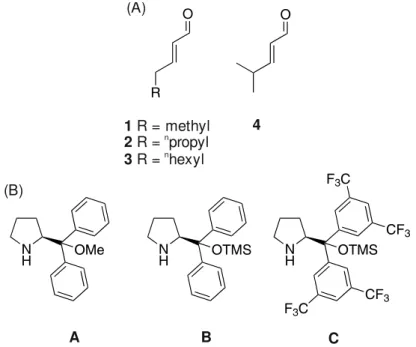
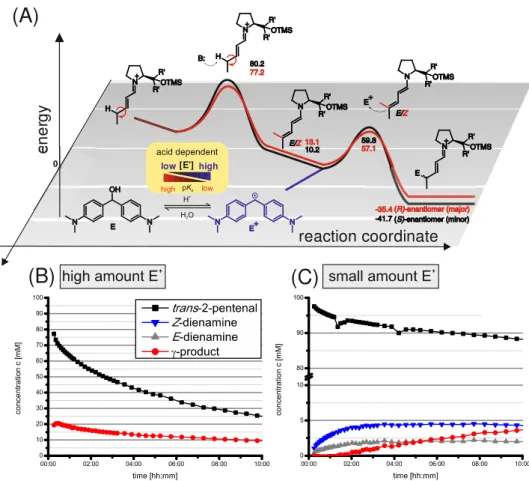
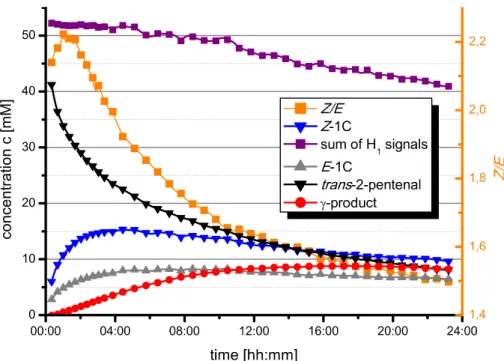
![Figure 10. Transition states of iminium ion product formation and their intermolecular interactions: (A) a closer distance shows a stronger CH-π interaction in [E + - Z -1C] ‡ ; (B) The alignment of the two dienamines subsyste](https://thumb-eu.123doks.com/thumbv2/1library_info/3853336.1516222/37.892.207.687.240.918/transition-formation-intermolecular-interactions-distance-interaction-alignment-dienamines.webp)
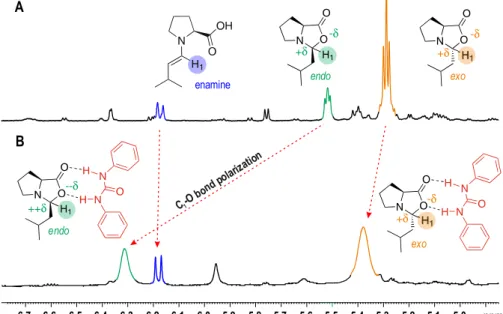
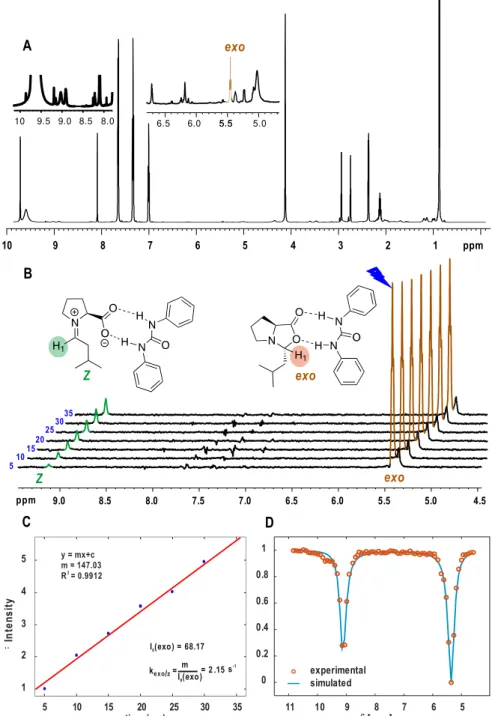
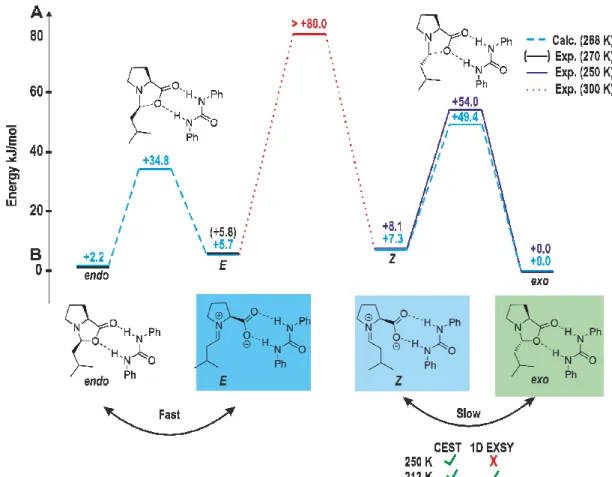
![Figure S8. Plot of [E-iminium]/[endo-oxazolidinone] population dependency on temperature (A); Variation of difference in free energy between endo-oxazolidinone and E-iminium structure with temperature, the – ΔS suggest more ordered stru](https://thumb-eu.123doks.com/thumbv2/1library_info/3853336.1516222/91.892.163.754.706.951/oxazolidinone-population-dependency-temperature-variation-difference-oxazolidinone-temperature.webp)
